brie
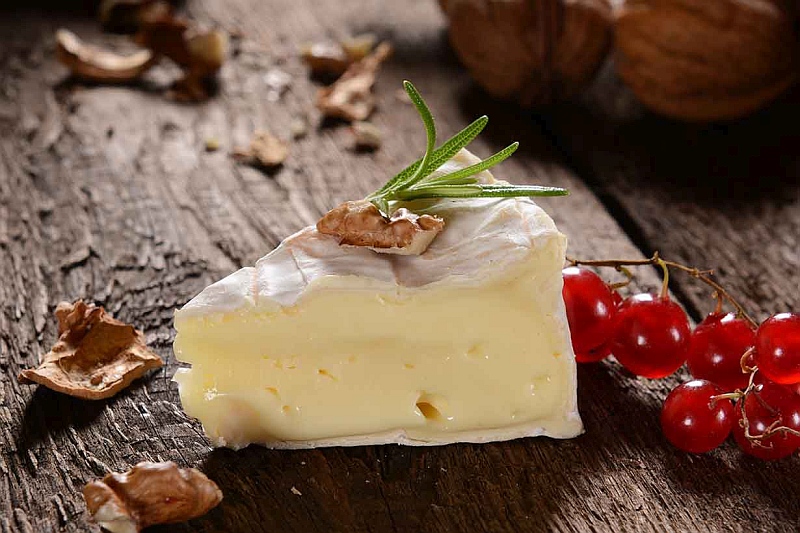
Made from unpasteurized cow's milk
Country of origin: France
Region: Seine-et-Marne
Family: Brie
Type: soft, artisan, soft-ripened
Fat content: 8.4 g/100g
Texture: buttery, runny and soft-ripened
Rind: bloomy
Colour: cream
Flavour: fruity, mild, nutty, tangy
Aroma: pronounced, strong
Vegetarian: no
Brie is the best known French cheese and has a nickname "The Queen of Cheeses". Brie is a soft cheese named after the French region Brie, where it was originally created. Several hundred years ago, Brie was one of the tributes which had to be paid to the French kings.
In France, Brie is very different from the cheese exported to the United States. "Real" French Brie is unstabilized and the flavour is complex when the surface turns slightly brown. When the cheese is still pure-white, it is not matured. If the cheese is cut before the maturing process, it will never develop properly. Exported Brie, however, is stabilized and never matures. Stabilized Brie has a much longer shelf life and is not susceptible to bacteriological infections.
Brie is produced from the whole or semi-skimmed cow's milk. Rennet is added into raw milk and heated to a temperature of 37°C to obtain the curd. The cheese is then cast into moulds, several layers of cheese are filled into the mould and then kept for around 18 hours. After this, the cheese is salted and aged for a minimum of four weeks.
Brie cheese is slightly pale in colour with a greyish tinge under a rind. Its flavour varies depending upon the ingredients added while producing the cheese.
Brie, one of the great dessert cheeses, comes as either a 1 or 2-kilogram wheel and is packed in a wooden box. In order to enjoy the taste fully, Brie must be served at room temperature.
wensleydale cranberries

Made from pasteurized or unpasteurized cow's or sheep's milk
Country of origin: United Kingdom
Region: North Yorkshire
Type: fresh firm
Texture: firm
Rind: natural
Colour: pale yellow
Flavour: creamy, sweet
Vegetarian: yes
Synonyms: Wensleydale , cranberry wensleydale
Wensleydale is a historic fresh, mild cheese made in Wensleydale, North Yorkshire since 1150 by Cistercian monks. These monks continued to make the cheese until the dissolution of their monasteries in 1540. Traditionally, sheep's milk was used, but over the time cow's milk was also used. The art of making the cheese was passed by the monks to the farmer's wives who produced a blue variety of Wensleydale at their farmhouses. Today, Wensleydale is produced mainly from pasteurised cow's milk with sheep's milk added to enhance the flavour. Wensleydale Creamery in the town of Hawes is seeking to protect the name Yorkshire Wensleydale Cheese under PDO designation. But there are other producers of Wensleydale cheese in parts of the UK, mainly in Shropshire and Cheshire.
Wensleydale with Cranberries is a hand-made Yorkshire cheese that is sold fresh & young at only three weeks old. The cheese has a sweet flavour of the fruity succulence of juicy cranberries with honeyed undertones.
gouda

Made from pasteurized or unpasteurized cow's, goat's or sheep's milk
Country of origin: Netherlands
Region: South Holland, Gouda
Family: Gouda
Type: semi-hard, artisan, brined, processed
Fat content (in dry matter): 76%
Fat content: 31 g/100g
Calcium content: 958 mg/100g
Texture: compact, crumbly, dense and springy
Rind: waxed
Colour: yellow
Flavour: creamy, full-flavored, nutty, sweet
Aroma: pungent
Vegetarian: no
Synonyms: Boerenkass Gouda, Graskaas Gouda, Jong Gouda
Alternative spellings: Goudam
Gouda, or "How-da" as the locals say, is a Dutch cheese named after the city of Gouda in the Netherlands. If truth be told, it is one of the most popular cheeses in the world, accounting for 50 to 60% of the world's cheese consumption. It is a semi-hard cheese celebrated for its rich, unique flavour and smooth texture. The original cheese markets in Gouda is one of the last standing commercial cheese markets in the Netherlands. Since the name is not protected, it has become a generic classification for all cheeses produced and sold under the name Gouda.
Gouda is typically made from pasteurised cow’s milk although some artisan varieties use sheep’s or goat’s milk to produce cheeses that are going to be aged for a long time. Boerenkaas is a typical variety of unpasteurised Gouda cheese produced by the farmers from the milk of cow's grazing on the natural, low pastures of Netherlands. There are seven different types of Gouda cheese, categorized depending on age. Graskaas is young Gouda ready to be consumed within weeks of production. On the other hand, is the extra aged, Overjarig cheese which has a full-flavoured, hard, golden interior and salty flavour reminiscent of toffee. Between the spectrums is a variety of Dutch Gouda’s classified as per the texture and age - Jong, Jong belegen, Belegen, Extra belegen, and Oud. Each cheese gets increasingly firmer in texture and richer in flavour than earlier classification. The waxed rind of the cheese also changes by the age as soft, younger Dutch Gouda cheese are identified by yellow, orange, or red wax rinds white mature cheese have black wax coverings.

Young Goudas are best paired with beer while medium cheeses taste best when paired with a fruity Riesling or Chenin Blanc. A well-aged Gouda complements wines that are deeply flavoured such as a rich Merlot or Shiraz. Gouda cheese may be grated, sliced, cubed or melted. It may be used as a table cheese or dessert cheese.
Gouda is available in large wheels with each weighing between 10 and 25 pounds.
aged gouda
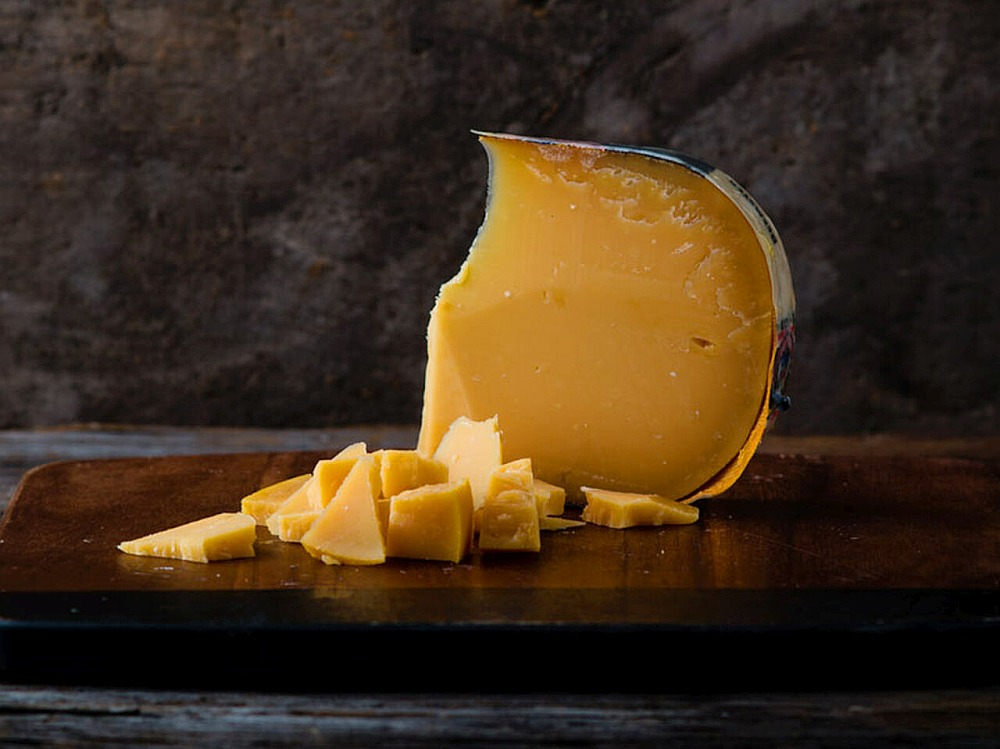
Made from pasteurized or unpasteurized cow's, goat's or sheep's milk
Country of origin: Netherlands
Region: South Holland, Gouda
Family: Gouda
Type: hard, artisan, brined, processed
Fat content (in dry matter): 76%
Fat content: 31 g/100g
Calcium content: 958 mg/100g
Texture: brittle, crumbly, crystalline and flaky
Rind: waxed
Colour: yellow
Flavour: burnt caramel, full-flavored
Aroma: rich, ripe
Vegetarian: no
Synonyms: Jong belegen Gouda, Belegen Gouda, Extra belegen Gouda, Oud Gouda, Overjarig Gouda, Five-Year Aged Gouda, Gouda, Aged Four Years
Gouda, or "How-da" as the locals say, is a Dutch cheese named after the city of Gouda in the Netherlands. If truth be told, it is one of the most popular cheeses in the world, accounting for 50 to 60 percent of the world's cheese consumption. There are several types of Gouda, classified by age. From all of these, hard-core Gouda fans prefer to taste the aged Gouda, as they feel it takes years of maturing to bring out the complex flavours of the cheese.
Aged Gouda is prepared similar to other Gouda cheeses by separating curds and whey through a heating process. It is shaped into a wheel that can be effectively sliced into wedged for consumption. As with all other cheeses, aged Gouda gets its colour by adding a colouring agent called annatto. With ageing, Gouda develops calcium lactate crystals formed by the lactic acid in the cheese. It proffers an enjoyable crunch that is unique to waxed cheeses. However, the rind of a five-year aged Gouda is unfit for human consumption.

The longer a cheese is kept in maturation cellars, the more aromatic and full-flavoured it becomes. Similarly, Aged Gouda such as a five-year aged cheese develops such a strong flavour that cheese aficionados prefer to eat it alone. Accompaniments seem pale in comparison to its caramel and robust flavour.
Gouda cheese as a hard cheese goes well with beer and red wines. The taste of Vintage or Aged Gouda gets a new definition when it is paired with some white wines and any fruity wine.
smoked gouda
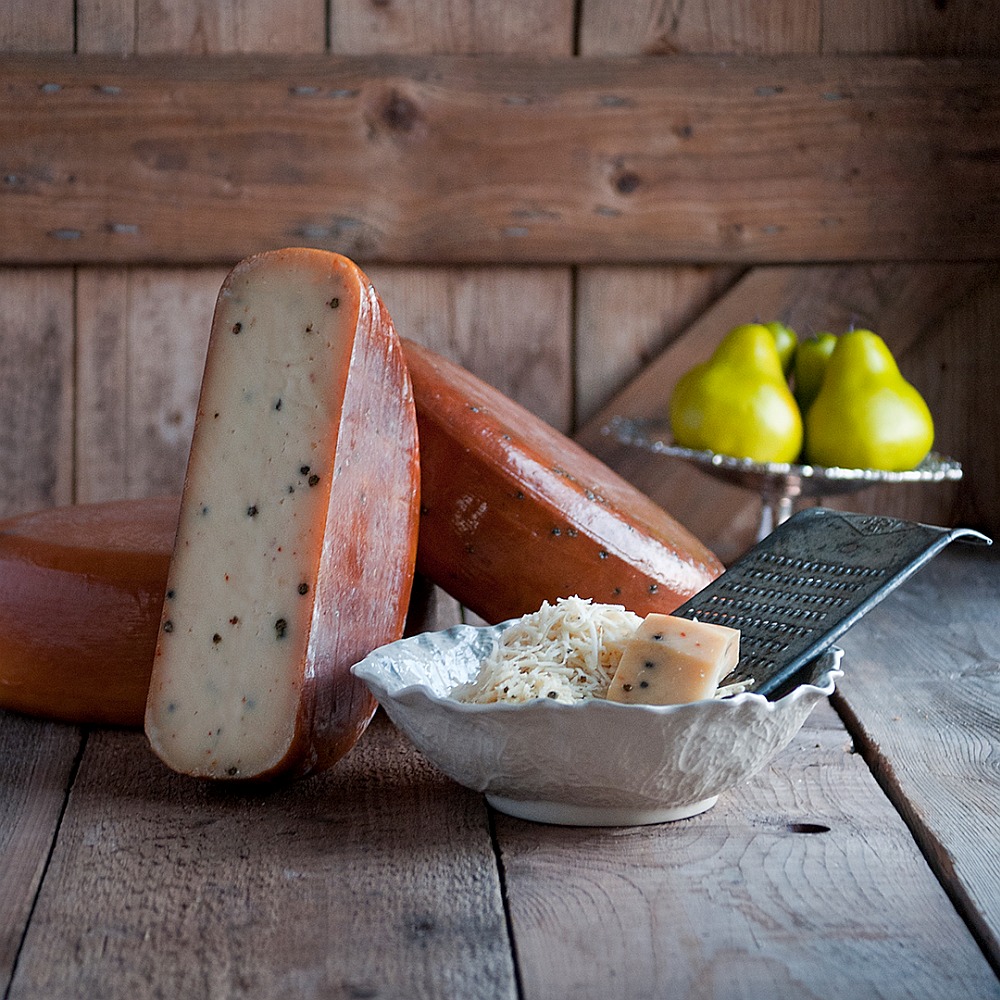
Made from pasteurized or unpasteurized cow's milk
Country of origin: Netherlands
Region: South Holland, Gouda
Family: Gouda
Type: hard, artisan
Fat content: 7 g/100g
Texture: buttery and crumbly
Rind: waxed
Colour: pale yellow
Flavour: smokey
Aroma: smokey
Vegetarian: no
Gouda, or "How-da" as the locals say, is a Dutch cheese named after the city of Gouda in the Netherlands. If truth be told, it is one of the most popular cheeses in the world, accounting for 50 to 60 percent of the world's cheese consumption. Smoked Gouda is a variant of this famous cheese wherein it is smoked in ancient brick ovens over flaming hickory chip embers. Sensational with beer, this hard cheese has an edible, brown rind and a creamy, yellow interior. It can also perfectly complement tasty snacks like fruits, nuts and dark chocolate. It forms a good combination of sandwiches and burgers.
cheddar

Made from pasteurized cow's milk
Country of origin: England
Region: Somerset
Family: Cheddar
Type: hard, artisan, processed
Fat content: 9 g/100g
Texture: compact and crumbly
Colour: pale yellow
Flavour: creamy, sharp
Vegetarian: no
Producers: Grafton Village Cheese Company, West Country Farmhouse Cheesemakers, Wexford Creamery, Williams Cheese Company , WSU Creamery
During olden days, England was the only place where Cheddar cheeses were made. However, many countries all over the world manufacture Cheddar today.
Any cheese producing company or any of the artisan manufacturers in any corner of the world can label the cheese produced by them as 'Cheddar' since it is not protected like other cheese names or brands.
Cheddar cheese, the most widely purchased and eaten cheese in the world is always made from cow's milk. It is a hard and natural cheese that has a slightly crumbly texture if properly cured and if it is too young, the texture is smooth. It gets a sharper taste as it matures, over a period of time between 9 to 24 months. Shaped like a drum, 15 inches in diameter, Cheddar cheese is natural rind bound in cloth while its colour generally ranges from white to pale yellow. However, some Cheddars may have a manually added yellow-orange colour.
Joseph Harding, the "father of Cheddar cheese" who invented modern cheese making techniques described the ideal quality of original Somerset Cheddar as "close and firm in texture, mellow in character or quality, rich with a tendency to melt in the mouth and has full and fine flavour somewhat like hazelnut!"
aged cheddar
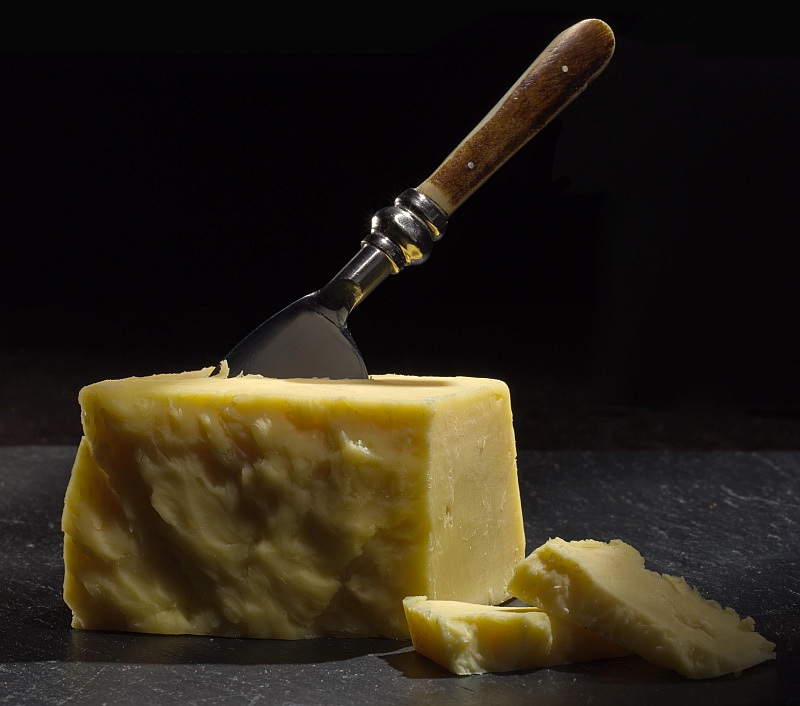
Made from pasteurized cow's milk
Country of origin: England
Region: Somerset
Family: Cheddar
Type: hard, artisan, processed
Fat content: 37.4 g/100g
Texture: brittle, crumbly, crystalline and flaky
Colour: pale yellow
Flavour: creamy, sharp and taste of sweetness
Vegetarian: no
Producers: multiple
All cheddar cheese is, technically, aged cheddar. Aging the cheese after it has been formed and pressed is part of the process required to make it into an edible and tasty cheese. At a minimum, cheddar cheese must be left to mature for roughly three months to have the character expected of mild cheddar. There are, however, aged cheddar cheeses that have been allowed to mature for 10 years or longer. As cheddar is allowed to age, its flavor becomes sharper and sweeter and its texture grows harder and more brittle.
Real aged cheddar has a distinct, sharp flavor and sweetness. It is best served at room temperature or only slightly chilled and eaten raw with slices of bread, crackers or fruits. The longer the cheese is aged, the less prone it is to melting smoothly and is best cooked as part of a mixture of cheeses that melt more smoothly.
applewood
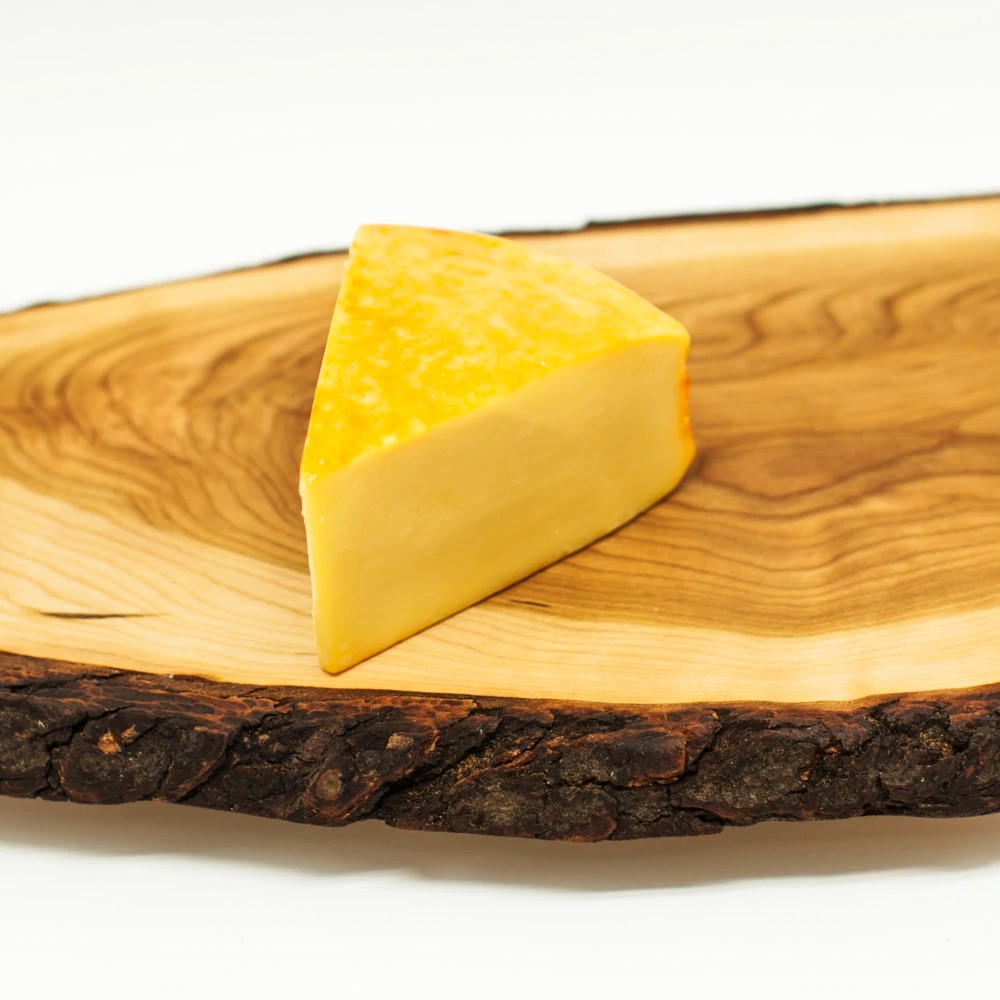
Made from pasteurized cow's milk
Country of origin: England, Great Britain and United Kingdom
Region: Somerset
Family: Cheddar
Type: semi-hard
Texture: crumbly and dense
Rind: natural
Colour: yellow
Flavour: smokey , spicy
Aroma: smokey
Vegetarian: yes
Producers: Ilchester Cheese Company
Synonyms: Applewood smoked cheddar
Applewood is a traditional farmhouse Cheddar from Ilchester Cheese Company. An English cheese, it also goes by the name of Applewood smoked cheddar. This dense semi-hard cheese was first invented in 1965 in Somerset, England.
Applewood is not actually smoked but given an artificial smoky flavouring with a dusting of paprika for a golden-amber appearance. The cheese can be crumbled or grated over pasta or melted on pork chops for that divine smokey taste. It also goes well with sweet apples and raisins.
parmesan
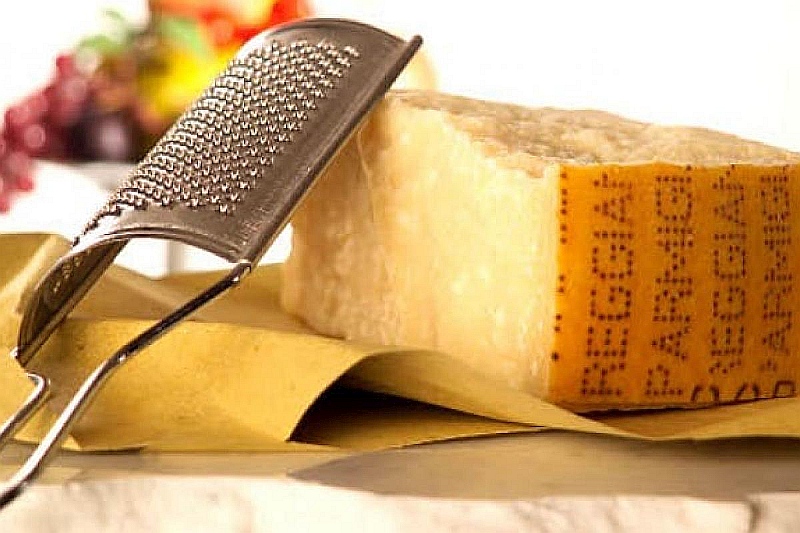
Made from unpasteurized cow's milk
Country of origin: Italy
Region: Provinces of Parma, Reggio Emilia, Modena, Bologna , Mantua
Family: Parmesan
Type: hard, artisan
Fat content: 25.83 g/100g
Calcium content: 1184 mg/100g
Texture: crystalline, dense and grainy
Rind: natural
Colour: straw
Flavour: fruity, nutty, savory, sharp
Aroma: strong
Vegetarian: no
Producers: Various
Synonyms: Parmigiano Reggiano
The Parmigiano Reggiano or Parmesan cheese as it is called in English is considered to be among the top cheeses by cheese connoisseurs. Today, it is produced by various producers. However, PDO designation states that for a cheese to be called as Parmesan, it has to be produced from cows grazing on fresh grass and hay.
Cheeses mocking Parmigiano Reggiano are called as Parmesan or Italian hard cheese by producers to avoid legal issues. Parmigiano Reggiano cheese is named after the provinces in which it is made, namely Provinces of Parma, Reggio Emilia, Modena, Bologna and Mantua.
True Parmesan cheese has a hard, gritty texture and is fruity and nutty in taste. Cheeses mocking Parmesan or inferior Parmesan may have a bitter taste. Parmigiano Reggiano cheese is mostly grated over pastas, used in soups and risottos. It is also eaten on its own as a snack.
blue vein cheese

Made from pasteurized or unpasteurized cow's, goat's or sheep's milk
Country of origin: countries throughout the world
Family: Blue
Type: semi-soft, blue-veined
Texture: creamy
Colour: blue
Flavour: salty, sharp, tangy
Aroma: stinky, strong
Vegetarian: no
Synonyms: Erborinato, Bleu cheese , Blue cheese
Blue Vein cheeses also called Blue cheese is a generic term used to describe cheese produced with cow's milk, sheep's milk, or goat's milk and ripened with cultures of the mould Penicillium. The final product is characterized by green, grey, blue or black veins or spots of mould throughout the body. These veins are created during the production stage when cheese is 'spiked' with stainless steel rods to let oxygen circulate and encourage the growth of the mould. This process also softens the texture and develops a distinctive blue flavour.
The origin of Blue cheese has an interesting story. It is thought to have been invented by accident when a drunken cheesemaker left behind a half-eaten loaf of bread in moist cheese caves. When he returned back, he discovered that the mould covering the bread had transformed it into a blue cheese.
Blue cheese is also identified by a peculiar smell that comes from cultivated bacteria. The flavour of the cheese depends on the type of blue cheese, shape, size, the climate of the curing and ageing period. But it generally tends to be sharp and salty. Some of the famous blue cheese around the world are Roquefort from France, Gorgonzola from Italy and Stilton from England.
Blue cheese tastes best when served with crackers, pears, raisins, fruit bread and walnuts. Crumble the cheese and melt it into sour cream, plain yoghurt or mayonnaise as a dressing.
gorgonzola

Made from pasteurized cow's milk
Country of origin: Italy
Region: Gorgonzola
Type: soft, blue-veined
Fat content: 25-35%
Texture: crumbly and firm
Colour: yellow
Flavour: mild, sharp
Aroma: nutty
Gorgonzola is one of the world's oldest blue-veined cheeses. The Cheese is mainly produced in the northern Italian regions of Piedmont and Lombardy, Gorgonzola. Unskimmed cow's milk is used while preparing the cheese. Generally, it takes three to four months to attain full ripeness.
This cheese has a crumbly and soft texture with a nutty aroma. It can have a mild to sharp taste depending on its age. Gorgonzola Dolce (also called Sweet Gorgonzola) and Gorgonzola Piccante (also called Gorgonzola Naturale, Gorgonzola Montagna, or Mountain Gorgonzola) are its two varieties, which vary in their age.
Gorgonzola can be consumed in many ways. It is served with wines like Bordeaux Blend (Red), Zinfandel and Sauternes.
mozzarella
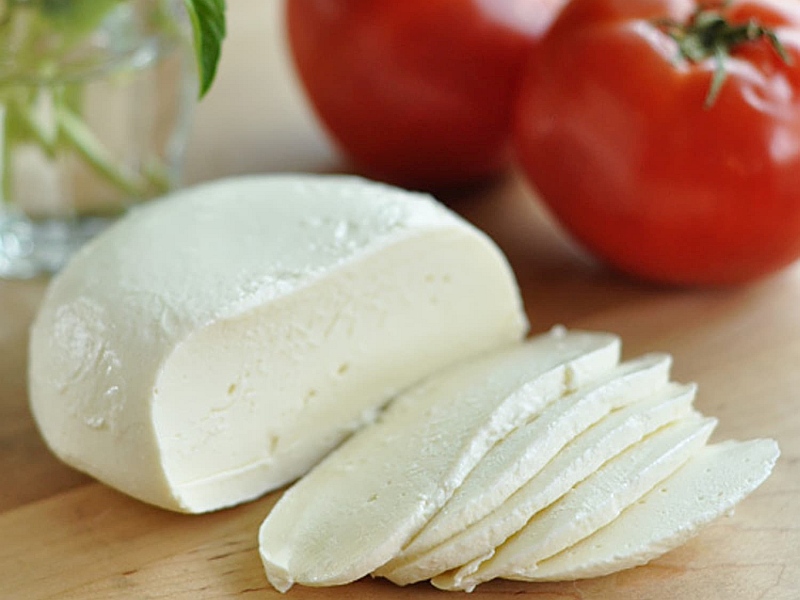
Made from pasteurized or unpasteurized cow's or water buffalo's milk
Country of origin: Italy
Region: Campania, Abruzzo, Molise and Puglia
Type: semi-soft, brined
Fat content: 45%
Calcium content: 403 mg/100g
Texture: springy, stringy and supple
Rind: rindless
Colour: white
Flavour: milky
Aroma: fresh, milky
Synonyms: mozerrela
Mozzarella cheese is a sliceable curd cheese originating in Italy. Traditional Mozzarella cheese is made from milk of water buffalos herded in very few countries such as Italy and Bulgaria. As a result, most of the Mozzarella cheeses available now are made from cow's milk.
An Italian Traditional Specialty Guaranteed (TSG) food product, Mozzarella cheese is not aged like most cheeses. It is eaten fresh and within few hours after it is made.
Fresh Mozzarella cheese is one of those easy-to-make-at-home cheeses used while making variety of recipes, including salads, meats, seafood, and vegetables.
Other types of Mozzarella:
Mozzarella di Bufala, also known as 'buffalo mozzarella', is made from domesticated water buffalo milk.
Mozzarella Fior di Latte is produced from fresh, pasteurised or unpasteurised cow milk, while Low-moisture mozzarella is made from whole or part skimmed milk. And last, but not least, Mozzarella affumicata is a smoked variety of Mozzarella.
swiss

Made from pasteurized cow's milk
Country of origin: United States
Family: Swiss Cheese
Type: hard, artisan, processed
Fat content: 7.8 g/100g
Texture: firm
Rind: rindless
Colour: pale yellow
Flavour: nutty, sweet
Vegetarian: yes
Producers: Various
Synonyms: American Swiss Cheese
Swiss cheese is a generic name for several varieties of cheese. It is an American version of the Swiss Emmental and is known for being a shiny, pale yellow colour. While it has a firmer texture than baby Swiss, its flavour is mild, sweet and nut-like. It has a savoury, but not very sharp taste. Some types of Swiss cheese have a distinctive appearance. Some cheeses have holes known as 'eyes' while some do not. Swiss cheese without eyes is known as 'blind'. But in general, the larger the eyes in Swiss cheese, the more pronounced its flavour!
The process of Swiss cheese making is designed in a way that no rind forms on the cheese. It can be eaten with fruits such as apples, pears, grapes and thinly-sliced prosciutto ham and salami. Fruity white wine, aged red wine, cran-raspberry juice, tomato or vegetable juices also prove to be great pairs for Swiss cheese.
feta

Made from pasteurized or unpasteurized goat's and sheep's milk
Country of origin: Greece
Region: Macedonia, Thrace, Thessaly, Central Mainland Greece, the Peloponnese, Lesvos and Island of Kefaloni
Family: Feta
Type: soft, brined
Fat content (in dry matter): 16%
Fat content: 21 g/100g
Calcium content: 493 mg/100g
Texture: creamy, crumbly, grainy and open
Colour: white
Flavour: full-flavored, salty, tangy
Aroma: nutty, strong
Vegetarian: no
Producers: CHRISTAKIS Greek Cheeses
Feta is undoubtedly one of the most famous Greek cheeses. In fact, Feta occupies 70% stake in Greek cheese consumption. The cheese is protected by EU legislation and only those cheeses manufactured in Macedonia, Thrace, Thessaly, Central Mainland Greece, the Peloponnese, Lesvos and Island of Kefalonia can be called ‘feta’. Similar cheeses produced elsewhere in the eastern Mediterranean and around the Black Sea, outside the EU, are often called ‘white cheese’.
To create traditional feta, 30 percent of goat's milk is mixed with sheep's milk of animals grazing on pastures in the specific appellation of origin regions. Nowadays, many stores sell goat and cow’s milk feta as well. The firmness, texture and flavour differ from region to region, but in general, cheese from Macedonia and Thrace is mild, softer and creamier, less salty with fewer holes. Feta made in Thessaly and Central Greece has a more intense, robust flavour. Peloponnese feta is dryer in texture, full flavoured and more open. Local environment, animal breeds, cultures all have an impact on the texture, flavour and aroma of feta.
On the whole, Feta is a pickled curd cheese that has a salty and tangy taste enhanced by the brine solution. The texture depends on the age which can be extremely creamy, or crumbly dry. Upon maturation of 2 months, feta is sold in blocks submerged in the brine. The cheese can be used a table cheese or melted on a traditional Greek salad, spanakopita, pizza or pie. It tastes delicious with olive oil, roasted red peppers and nuts. If required, it can be washed under water to remove the extra saltiness. The salty flavour of Feta pairs well with beer, Pinot Noir, Sauvignon Blanc and Zinfandel.
emmentaler
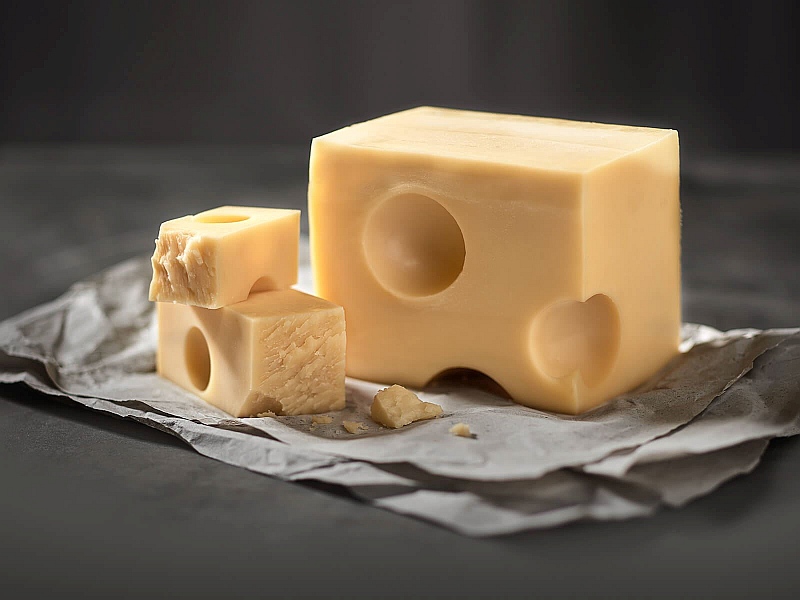
Made from cow's milk
Country of origin: Switzerland
Type: hard
Vegetarian: no
Producers: Entremont
Alternative spellings: Emmenthal, Emmenthaler, Emmentaler
This cheese is produced in the central cantons of Switzerland. It is a traditional, unpasteurised, hard cheese made from cow's milk. It's hard, thin rind is covered by paper with producer's name on it. The aroma is sweet with tones of fresh-cut hay. The flavour is very fruity, not without a tone of acidity. Emmental has walnut-sized holes. It is considered to be one of the most difficult cheeses to be produced because of it's complicated hole-forming fermentation process. The cheese tastes delicious with a glass of wine, for example Jura Blanc.
camembert
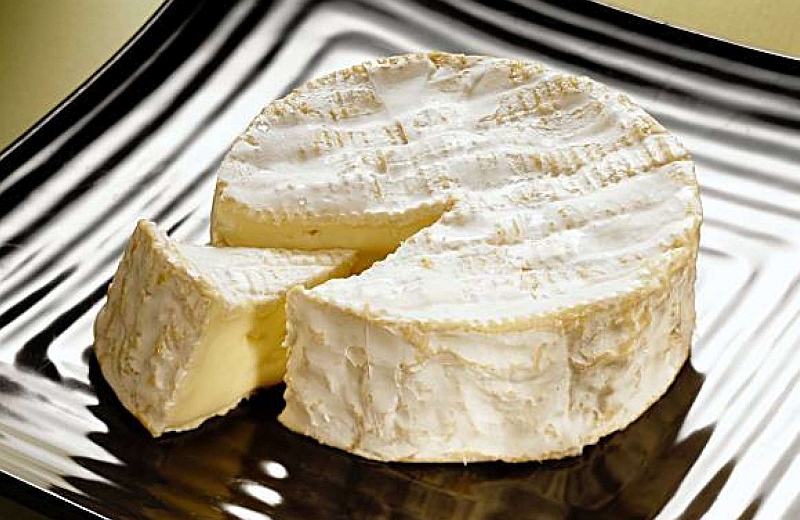
Made from unpasteurized cow's milk
Country of origin: France
Region: Normandy, Camembert
Family: Camembert
Type: soft, artisan, soft-ripened
Fat content: 45%
Texture: chalky, runny, smooth, soft, soft-ripened and supple
Rind: bloomy
Colour: pale yellow
Flavour: buttery, creamy, milky, sweet
Aroma: earthy
Vegetarian: no
Synonyms: Camembert Le Châtelain, Camembert de Normandie PDO
Marie Harel created the original Camembert cheese from raw milk in Normandy, France in 1791. Today, however, a very small percentage of producers make cheese from raw milk with the same process as Marie Harel would have used. Those who produce cheese using Marie Harel's method, can legally call their cheese Camembert Normandie under the AOC guidelines. However, the production of Camembert cheese has now transcended the AOC designation. Very good varieties of Camembert cheese made from pasteurised milk can be found in Normandy today. The best of them is the Camembert Le Châtelain.
The fresh Camembert cheese is bland, hard and crumbly in texture. Young Camembert has a milky and sweet taste. As the cheese matures it forms a smooth, runny interior and a white bloomy rind that is typical to Camenbert cheese. It has a rich, buttery flavour. The rind is bloomy white caused by a white fungus, called penicillium candidum.The rind is meant to be eaten with the cheese.
This cheese is best paired with a light red wine such as Beaujolais, Chenin Blanc, St Emilion, St Estephe or traditionally a glass of Normandy cider.
cottage cheese

Made from pasteurized or unpasteurized cow's milk
Country of origin: United Kingdom and United States
Family: Cottage
Type: soft, artisan, processed
Fat content (in dry matter): 4%
Fat content: 4.30 g/100g
Calcium content: 68 mg/100g
Texture: creamy and crumbly
Rind: rindless
Colour: white
Flavour: sweet
Cottage cheese has a mild flavour and is a cheese curd product. The curd is drained but not pressed, so some whey remains and retains moisture. The curd is generally washed to remove the acidity and leave a sweet taste. It is made from different types of milk with different fat levels.
The term 'cottage cheese' is believed to have originated because the cheese was generally made in cottages from milk left over, after making butter. Cottage cheese can be eaten by itself, with fruits, toast or even used in salads. The cheese is creamy, lumpy and sold in pots.
fruity cream cheese
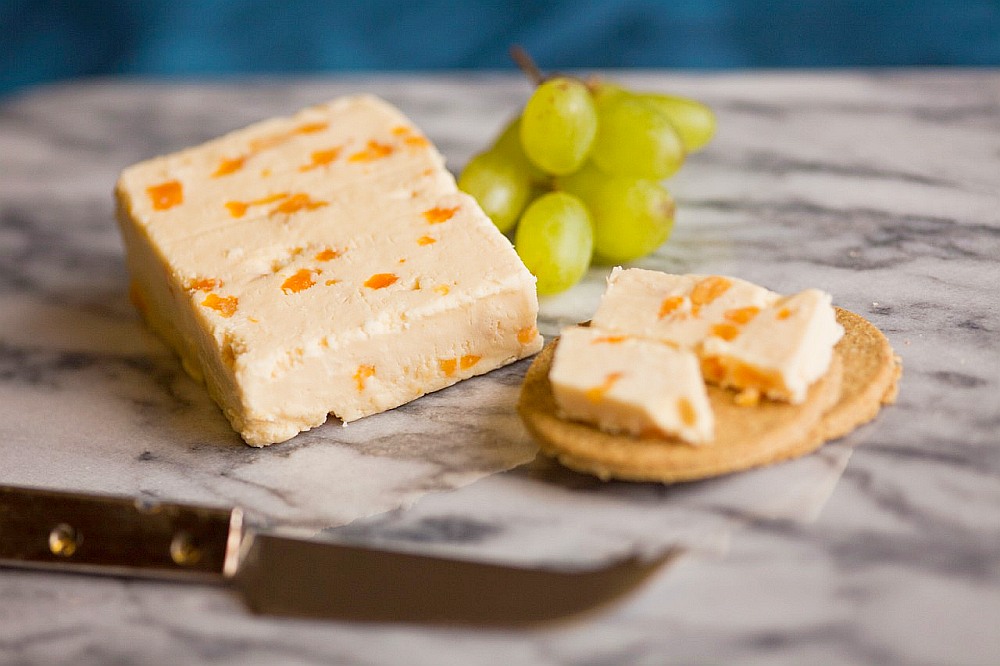
Made from pasteurized or unpasteurized cow's milk
Country of origin: United States
Region: Chester, New York
Type: fresh soft, processed
Fat content: 65%
Calcium content: 98 mg/100g
Texture: creamy and spreadable
Rind: rindless
Colour: white
Flavour: creamy, mild, sweet
Aroma: fresh, pleasant
Vegetarian: yes
Producers: Kraft Foods Company
Synonyms: fruit cream
Alternative spellings: Fruit cream cheese
Fruity cream cheese is a fresh, soft mild tasting cream cheese produced from unskimmed cow’s milk. Given that it is made from a combination cream and milk, the cheese has a high fat content. In the US, cream cheese need to contain at least 33% fat content while in Britain it should be a minimum of 45-65%. Anything above is considered double or triple cream cheese. In German, it is also called Doppelrhamstufel meaning cheese made with "double cream". The cheese has a mildly lactic aroma and a slightly salty taste.
Cream cheese is firmed with the use of lactic acid and so needs to be consumed fresh. It has a relatively short life even when refrigerated. Cream cheeses made using traditional methods tend to be more crumbly than spreadable while those with stabilizers like guar gum are more firm. The taste, texture and production are similar to Boursin and Mascarpone. Cream cheese is suitable for vegetarians since it uses acid, such as citric acid to coagulate the milk.
Cream cheese has a mild, sweet taste with a pleasant slight tang. It is a smooth, spreadable cheese at room temperature and comes in various flavoured varieties including those with herbs, fruits blended in. The cheese is widely consumed in United States where it used to enrich cheesecakes, frostings, dips, toppings, sweet & savory dishes and desserts. It is also used to make flavourful desserts with colourful fruit combinations such as blueberries, raspeberries and kiwis.
apolline aux fleur

Made from pasteurized goat's milk
Country of origin: France
Region: Center-Val de Loire
Type: soft, artisan
Texture: creamy, smooth
Rind: edible flowers
Color: white
Flavour: a rose candy is inserted in the centre of the cheese with edible flowers on the outside. Flavours of flowers, sweet goat milk and rose.
Aroma: floral
Vegetarian: no
Apolline aux fleurs is made in the Berry region by the prestigious Jacquin cheese factory, which specializes in the production of quality small goats. To this day, its reputation is well established since for more than 60 years, they have maintained family traditions of superior quality research while respecting traditional methods. This delicate little cheese is made from pasteurized goat's milk and is named in honor of Apolline, the daughter of Romain Jacquin, owner of the Fromagerie.
A rose candy is inserted in the center of a fresh dung which gives it a smooth and sweet heart. A few edible flowers are added last on the outside of the cheese to add some nice color to it. It has a white paste with a creamy and melting texture. FLAVORS: With delicate aromas of flowers and milk, you will discover a goat and rose flavor.
HOW TO TASTE IT: Perfect on a cheese board, it can be eaten plain with crackers. It goes well with a rosé wine or a glass of champagne.
Credit - data sourced from CHEESE.COM